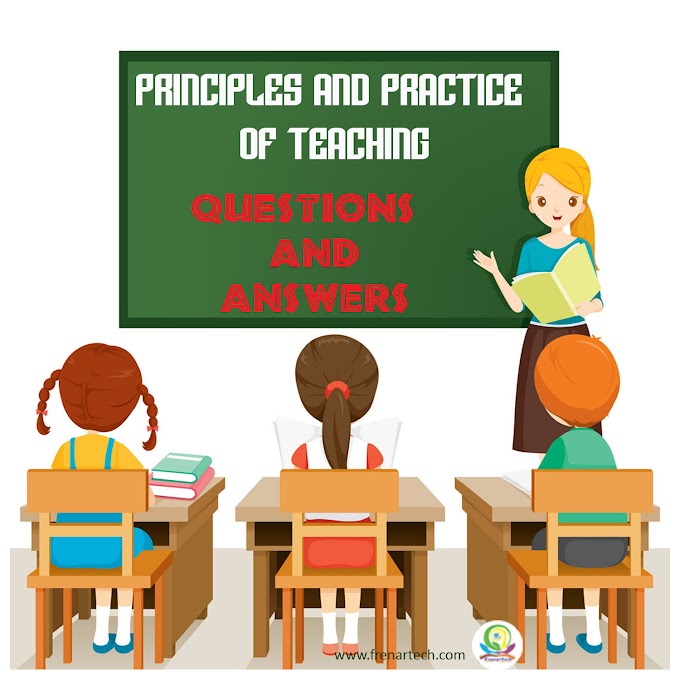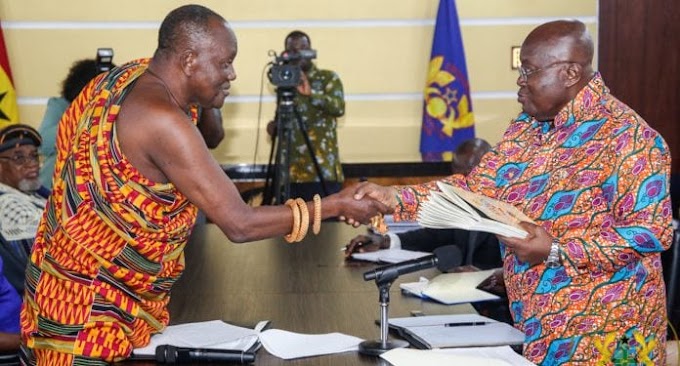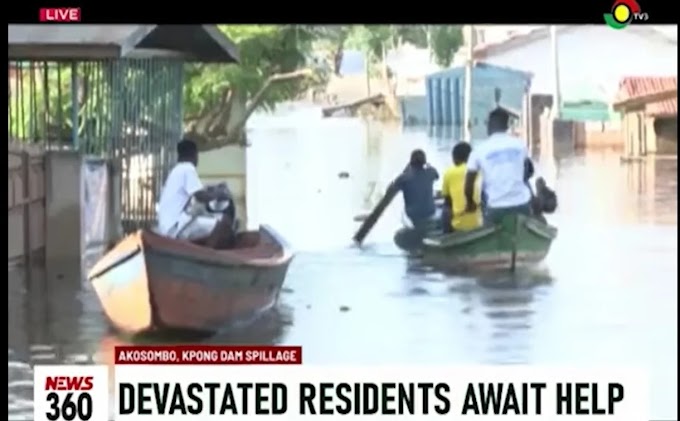1. A pedagogical approach which emphasizes the use of play to promote the socio-emotional and mental development of the learner can best be associated with ... Select one:
a. Play-based learning
b. Problem-based learning
c. Learning through play
d. Reflection
ANSWER : A
2. In problem-based learning, one must consider all these factors except; Select one:
a. the learner must have some knowledge about the problem to be solved
b. develop appropriate knowledge and skills to use in problem- based learning
c. provide instruction to cater for the needs of learners
d. the problem should target a group of learners because of individual differences
ANSWER : D
3. A teacher who goes by the principles of teaching will succeed in doing all these except...... Select one:
a. Creating pupils' affection for him/her.
b. Arousing pupils' interest in lessons.
c. Ensuring retention of what is learnt.
d. Sustaining interest of pupils.
ANSWER : A
4. A newly posted teacher observed that his students approach to answering questions were unsatisfactory. Which of these integrated pedagogies would you suggest that the teacher uses as a strategy to develop problem solving skills among his students? Select one:
a. Assisted discovery
b. Project based learning
c. Problem based learning
d. Learning through play
ANSWER : C
5. When a teacher provides adequate support to students during classroom interaction, which one of these learning is most likely to occur? Select one:
a. Enquiry based learning
b. Guided discovery
c. Problem based learning
d. Pure discovery
ANSWER : B
6. A good teacher would say to him/herself:
"It is not all students in my class who can be good in mathematics, just as it is not all every student who can draw". The teacher is being guided by which principle of teaching? Select one:
a. Principle of setting clear goals.
b. Principle of self-activity.
c. Principle of individual differences.
d. Principle of assessment.
ANSWER : C
7. Guided discovery helps learners to achieve one of the following; Select one:
a. Learners are motivated to memorize facts and concepts
b. It helps learners to challenge themselves by performing more complex tasks
c. Learners show positive interest and self-motivation for their own learning
d. It promotes argumentation which allows for feedback
ANSWER : C
8. In delivering a new lesson, a teacher takes into account the learners' relevant previous knowledge (RPK). Which of these principles best suggests what the teacher is considering? Select one:
a. Principle of continuity and unity.
b. Principle of adequate preparation.
c. Principle of use of teaching and learning materials.
d. Principle of selection.
ANSWER : B
9. One of the advantages of using the Reflect-Connect-Apply (RCA) concept as a teaching strategy is that
Select one:
a. it develops only the psychomotor domain of the learner
b. learners are narrow in their higher-order thinking skills
c. it limits the use of integrated pedagogies to promote collaboration and team work
d. learners reflect and link their prior experiences in real life situations
ANSWER : D
10. The competency learners acquire when they are encouraged to discover and communicate through ICT to support their academic achievement is ... Select one:
a. Cultural identity
b. Communication and collaboration
c. Skills in creativity
d. Digital literacy skills
ANSWER : D
11. For a teacher's academic quality, he/she should be seen as ... Select one:
a. having very much interest in all the topics that are to be taught.
b. someone who can make the pupils reason on highly controversial issues.
c. one who has great understanding and knowledge of the subject matter
d. being very eager to teach all the topics spelt out in the syllabus
ANSWER : C
SECTION I (MCQs - QUIZ 1 B)
1. Otterlei's taxanomy which describes the most salient characteristics of a profession includes all the following except Select one:
a. Education, Competence and Discretion
b. Monopoly
c. Skills Techniques and methods
d. Autonomy, ethical rules and self control
ANSWER: C
2. Appropriate and effective use of learning resources is a
a. Personal quality
b. personal quality
c. an academic quality
d. professional quality
ANSWER: D
3. Which one of these is not a psychological principle of teaching? Proceed from
a. simple to difficult
b. known to unknown
c. complex to simple
d. concrete to abstract
ANSWER: C
4. Which one of the following conceptions of teaching is based on teacher’s own intuition and personal preference? Teaching as an/a
a. Science
b. skill
c. art
d. Profession
ANSWER: C
5. The guidelines for presenting content to make it easy is referred to as Select one:
a. techniques of teaching
b. principles of teaching
c. teaching strategies
d. methods of teaching
ANSWER: B
6. Teaching as a science centres around
a. Experiences gained in the field of teaching
b. Logical presentation of the lesson
c. Teacher centeredness of the lesson
d. Questioning techniques
ANSWER: B
7. A major goal for teaching is to ensure that Select one:
a. learners are passive
b. learning takes place
c. the teacher is effective
b. the class is interactive
ANSWER: B
8. My name is Mr. Zee and needs members. Anyone who wants to be a member of my group must have these attributes: Be able to work within my rules, have peculiar knowledge, freedom to execute his or her duties, knows opportunities available for him or her and above all, take notice of what society says about me. Who is Mr. ZEE in this scenario? Teacher Select one:
a. Profession
b. Occupation
c. Professional
d. Teacher
ANSWER: A
9. Which of the following activities has an objective of developing the cognitive domain only?
Select one:
a. Teaching
b. Reflection
c. Instruction
d. Learning
ANSWER: C
10. As a teacher, Mr. Zee constantly goes over what he teaches his pupils during a lesson. What principle of teaching does Mr. Zee apply in this regard?
Select one:
a. Principle of Review/Recapitulation
b. Principle of Measurement
c. Principle of individual differences
d. Principle of Reinforcement
ANSWER: A
11. One similarity between teaching and instruction is that both Select one:
a. develop the head, heart and hand.
b. are pedagogical approaches.
c. involve complex processes and activities.
d. are needed to help learners develop.
ANSWER: B
12. Mr. Anokye of Adiembra M /A Basic School is a responsible and dedicated Mathematics teacher who has the interest of his students at the centre of his teaching. He has a sense of humour, very humble, has in-depth knowledge of the subject matter and flexible, yet does not compromise on quality. These traits of Mr. Anokye qualifies him as
a. a good motivator
b. a disciplinarian
c. an inspirer
d. a good teacher
ANSWER: D
13. Teaching in the 21st century has been influenced by the Select one:
a. Positivist approach
b. Pragmatist approach
c. constructivist approach
d. interpretivist approach
ANSWER: C
14. As a result of covid 19, schools were closed down for some time. A teacher wants to cover a large area of topics in the curriculum in other to adequately prepare students for the final examinations. Which of the following methods or strategies is likely to be used by the teacher?
Select one:
a. role play
b. project
c. Teacher centred
d. Learner centred
ANSWER: C
15. Sense of humour in teaching is
a. an academic quality
b. a personal quality
c. a professional quality
d. a Personal quality
ANSWER: B & D
16. The teacher's world view about teaching which guides his or her teaching is referred to as what?
a. Philosophy
b. Theory
c. Concept
d. View
ANSWER: A
17. The idea that anybody can become a teacher is a
a. Misconception
b. Fact
c. Mystery
d. Belief
ANSWER: A
18. Theories, methods, techniques and strategies used in teaching adults is referred to as what?
a. Pedagogy
b. Approach
c. Andragogy
d. Skills
ANSWER: C
19. An occupation has a defined body of skills and knowledge which beyond the knowledge of who?
Select one:
a. trained person
b. lay person
c. professional
d. member of the occupation
ANSWER: B
20. Which of the following activities has an objective of an overall development of an individual?
a. Teaching
b. Instruction
c. Learning
d. Reflection
ANSWER: A
21. Which of the following activities has an objective of developing the cognitive domain only? Select one:
a. Instruction
b. Reflection
c. Teaching
d. Learning
ANSWER: A
22. Theories, methods, techniques and strategies used in teaching adults is referred to as what? Select one: a. Andragogy
b. Approach
c. Pedagogy
d. Skills
ANSWER: A
23. One similarity between teaching and instruction is that both Select one:
a. are pedagogical approaches.
b. involve complex processes and activities.
c. are needed to help learners develop.
d. develop the head, heart and hand.
ANSWER: A
24. A major goal for teaching is to ensure that Select one:
a. the class is interactive
b. learners are passive
c. the teacher is effective
d. learning takes place
ANSWER: D
25. Teaching as a science centres around Select one:
a. Logical presentation of the lesson
b. Teacher centeredness of the lesson
c. Experiences gained in the field of teaching
d. Questioning techniques
ANSWER: A
26. An occupation has a defined body of skills and knowledge which beyond the knowledge of who?
Select one:
a. professional
b. lay person
c. member of the occupation
d. trained person
ANSWER: B
27. Which of the following activities has an objective of an overall development of an individual? Select one: a. Instruction
b. Reflection
c. Learning
d. Teaching
ANSWER: D
28. Appropriate and effective use of learning resources is a
Select one:
a. a professional quality
b. a personal quality
c. an academic quality
d. a Personal quality
ANSWER: A
29. Teaching in the 21st century has been influenced by the
Select one:
a. constructivist approach
b. Pragmatist approach
c. Positivist approach
d. interpretivist approach
ANSWER: A
30. The teacher's world view about teaching which guides his or her teaching is referred to as what? Select one:
a. Concept
b. View
c. Philosophy
d. Theory
ANSWER: C
SECTION II (MCQ –QUIZ 2 A)
1. A pedagogical strategy that enables learners to process their experience by reflecting and sharing their opinion with their peers is
Select one:
a. Connect
b. Reflect-Connect-Apply
c. Apply
d. Reflect-Apply
ANSWER: B
2. Which one of these core competencies of play-based learning mostly enables learners to accept situations and take responsibility for their own learning?
Select one:
a. Creativity and Innovativeness
b. Cultural identity and global citizenship
c. Digital literacy
d. Critical thinking and problem solving
ANSWER: D
3. One of the advantages of using the Reflect- Connect-Apply (RCA) concept as a teaching strategy is that
Select one:
a. it limits the use of integrated pedagogies to promote collaboration and team work.
b. learners reflect and link their prior experiences in real life situations
c. learners are narrow in their higher- order thinking skills
d. it develops only the psychomotor domain of the learner
ANSWER: B
4. In an Early Grade class, the learning environment is effectively organised such that the children learn based on their personal experiences, skills, interest and abilities. Which of the following concepts best describes this activity?
Select one:
a. Play based learning
b. Problem based learning
c. Enquiry based learning
d. Play
ANSWER: A
5. The teachers' ability to psychologise the subject matter is known as Select one:
a. Knowledge of Learners
b. Content knowledge
c. Pedagogical content knowledge
d. Knowledge of educational ends
ANSWER: A
6. Teaching as a science centres around Select one:
a. Teacher centeredness of the lesson
b. Logical presentation of the lesson
c. Experiences gained in the field of teaching
d. Questioning techniques
ANSWER: B
7. Which one of these is not a psychological principle of teaching? Proceed from Select one:
a. complex to simple
b. simple to difficult
c. known to unknown
d. concrete to abstract
ANSWER: A
8. Which one of the following conceptions of teaching is based on teacher's own intuition and personal preference?
Teaching as an/a Select one:
a. skill
b. profession
c. science
d. art
ANSWER: D
9. As a result of covid 19, schools were closed down for some time. A teacher wants to cover a large area of topics in the curriculum in other to adequately prepare students for the final examinations. Which of the following methods or strategies is likely to be used by the teacher?
Select one:
a. project
b. role play
c. Learner centred
d. Teacher centred
ANSWER: D
10. Which of the following statement is not true about projects? It is Select one:
a. a teacher centred activity
b. proceeded in social environment
c. a purposeful activity
d. accomplished in real life
ANSWER: A
11. The guidelines for presenting content to make it easy is referred to as Select one:
a. methods of teaching
b. teaching strategies
c. principles of teaching
d. techniques of teaching
ANSWER: C
11. A major goal for teaching is to ensure that Select one:
a. the teacher is effective
b. the class is interactive
c. learners are passive
d. learning takes place
ANSWER: D
12. The following principles must be considered when selecting teaching techniques except Select one:
a. suitability of technique to the teacher and the topic
b. individual differences in the classroom
c. interest of learners on the topic
d. suitability of the technique to the learner and the topic
ANSWER: A
13. Mr. Anokye of Adiembra M /A Basic School is a responsible and dedicated Mathematics teacher who has the interest of his students at the centre of his teaching. He has a sense of humour, very humble, has in-depth knowledge of the subject matter and flexible, yet does not compromise on quality. These traits of Mr. Anokye qualifies him as Select one:
a. an inspirer
b. a good motivator
c. a disciplinarian
d. a good teacher
ANSWER: D
14. Which one of these is not a psychological principle of teaching? Proceed from Select one:
a. concrete to abstract
b. known to unknown
c. simple to difficult
d. complex to simple
ANSWER: D
15. Teaching is based on teacher's own intuition and personal preference?
Teaching as an/a Select one:
a. profession
b. science
c. art
d. skill
ANSWER: C
16. A major goal for teaching is to ensure that Select one:
a. the teacher is effective
b. the class is interactive
c. learning takes place
d. learners are passive
ANSWER: C
17. As a result of covid 19, schools were closed down for some time. A teacher wants to cover a large area of topics in the curriculum in other to adequately prepare students for the final examinations. Which of the following methods or strategies is likely to be used by the teacher? Select one:
a. role play
b. Teacher centred
c. project
d. Learner centred
ANSWER: B
18. Teaching as a science centres around Select one:
a. Teacher centeredness of the lesson
b. Experiences gained in the field of teaching
c. Questioning techniques
d. Logical presentation of the lesson
ANSWER: D
18. The teachers' ability to psychologise the subject matter is known as Select one:
a. Content knowledge
b. Knowledge of educational ends
c. Knowledge of Learners
d. Pedagogical content knowledge
ANSWER: C
19. The following principles must be considered when selecting teaching techniques except Select one:
a. interest of learners on the topic
b. suitability of the technique to the learner and the topic
c. suitability of technique to the teacher and the topic
d. individual differences in the classroom
ANSWER: C
20. Which of the following statement is not true about projects? It is Select one:
a. a purposeful activity
b. accomplished in real life
c. a teacher centred activity
d. proceeded in social environment
ANSWER: C
21. Guided discovery helps learners to achieve one of the following; Select one:
a. Learners show positive interest and self-motivation for their own learning
b. Learners are motivated to memorize facts and concepts
c. It helps learners to challenge themselves by performing more complex tasks
d. It promotes argumentation which allows for feedback
ANSWER: A
22. Learners become digitally literate when they... Select one:
a. are able to read, write and speak fluently
b. develop values of integrity and diversity
c. communicate through ICT in their learning
d. share ideas and accept divergent views
ANSWER: C
23. In a first lecture in a University, students were asked to search for information independently from the reference list on the course outline to solve a given task. Which one of the following integrated pedagogies best describes this practice? Select one:
a. Play-based learning
b. Pure discovery learning
c. Project based learning
d. Enquiry based learning
ANSWER: B
24. The core competence of play-based learning which is likely to enable learners to be independent and original in their learning is Select one:
a. Personal development
b. Problem solving
c. Global citizenship
d. Creativity and innovation
ANSWER: D
25. The following are characteristics of project-based learning except; Select one:
a. It challenges learners to generate new ideas
b. It is a teacher led activity
c. Projects produce realistic and authentic ideas
d. Projects are framed around driving questions and hypothesis
ANSWER: B
26. In problem-based learning, one must consider all these factors except; Select one:
a. the learner must have some knowledge about the problem to be solved
b. develop appropriate knowledge and skills to use in problem-based learning
c. provide instruction to cater for the needs of learners
d. the problem should target a group of learners because of individual differences
ANSWER: D
27. For a teacher's academic quality, he/she should be seen as ... Select one:
a. having very much interest in all the topics that are to be taught.
b. someone who can make the pupils reason on highly controversial issues.
c. one who has great understanding and knowledge of the subject matter
d. being very eager to teach all the topics spelt out in the syllabus
ANSWER: C
SECTION III (MCQ –QUIZ III )
1. One of the assumptions of learner-centred method of teaching is that the Select one:
a. basic focus is learner activity
b. teacher is seen as the bearer of all knowledge
c. learners learn the same way
d. leaners are passive
ANSWER : A
2. When a teacher varies his/her pedagogies during lesson delivery, it is most likely to lead to the attainment of Select one:
a. mastering of the content
b. desired learning outcomes
c. effective teaching
d. making leaners passive
ANSWER : B
3. Enquiry-based learning is characterized by its emphasis on all of the following except
Select one:
a. process.
b. questioning.
c. active teacher involvement.
d. building on prior knowledge.
ANSWER : C
4. The cross cutting elements of teaching include all of the following EXCEPT Select one:
a. Learner
b. Parents
c. Teacher
d. Subject Content
ANSWER : B
5. Which technique of teaching promotes classroom interaction between teachers and learners? Select one:
a. Lecture technique
b. Questioning and responding
c. Teacher-led demonstration
d. Drill and practice
ANSWER : B
6. Which of the following is not ONE of the objectives of integrated pedagogies? Select one:
a. Ensuring the head of the learner is filled with adequate knowledge
b. Applying the learning to practical situations
c. Linking the learning process to real-life situations
d. Focusing on the importance of the learning situation
ANSWER : A
7. An activity or action designed to produce change in student’s behaviour can be referred to as Select one:
a. Performance
b. Andragogy
c. Instruction
d. Teaching
ANSWER : C
8. The reasons teachers use the teacher-centred method include all the following except
Select one:
a. To cover a large area of knowledge in order to prepare leaners for examination
b. To provide information otherwise not available to learners
c. To introduce new knowledge which may be mainly theoretical
d. To promote lifelong learning
ANSWER : D
9. Mr. Danso of St. Paul SHS is an ICT teacher who has the interest of his students at the centre of teaching and learning. He has in-depth knowledge in computing and a sound knowledge about his learners and their developmental needs. Above all, he is a life-long learner. The traits Mr. Danso possess can best be described as
Select one:
a. leadership qualities
b. professional qualities
c. academic qualities
d. personal qualities
ANSWER : C
10. The worldview about teaching which guides a teacher’s teaching and how learning should occur is known as teaching
Select one:
a. Philosophy
b. Method
c. Technique
d. Strategy
ANSWER : A
11. The following are objectives of integrating pedagogies except Select one:
a. ensuring the learning process is applicable to real life situations.
b. teaching the learner to relate the learned material to practical situations.
c. to improve the skills of questioning during lesson delivery.
d. to organise knowledge and skills to deal with daily events
ANSWER : C
12. When students search for information independently from the reference list on a course outline to perform a given task, the integrated pedagogy employed is Select one:
a. Enquiry based learning.
b. Project based learning.
c. Play-based learning.
d. Pure discovery learning.
ANSWER : D
13. The goals of instructions in the leaner-centred method does not include one of the following Select one:
a. Enhance critical thinking
b. Introduce a new concept which is abstract to learners.
c. Promote life-long learning
d. Encourage personal empowerment
ANSWER : B
14. When teaching, the guidelines for presenting content to make it easy for understanding is referred to as Select one:
a. techniques of teaching.
b. methods of teaching.
c. principles of teaching.
d. teaching strategies.
ANSWER : C
15. What is the recommended group size in collaborative and cooperative learning?
Select one:
a. 2-5 learners.
b. 4-6 learners.
c. 10-15 learners.
d. 5-10 learners.
ANSWER : A
16. Which of the following statement is not true about project-based learning?
Select one:
a. It is a purposeful activity.
b. It proceeded in social environment.
c. It is accomplished in real life.
d. It is a teacher centred activity.
ANSWER : D
17. Which of the following is NOT an assumption of a teacher-centred method of teaching?
Select one:
a. Learners are passive
b. Learners have the same learning needs
c. Learners have different learning needs
d. Learners have no knowledge
ANSWER : D
18. What is the recommended group size in collaborative and cooperative learning?
Select one:
a. 5-10 learners
b. 2-5 leaners
c. 4-6 learners
d. 10-15 learners
ANSWER : B
19. All the following are qualities of a good teacher except
I. Has a sense of humour, II. Has adequate knowledge of the subject matter, III. Is fair and consistent, IV. Gives preferential treatment to brilliant students
Select one:
a. III and IV only
b. I and III only
c. I and II only
d. IV only
ANSWER : D
20. The meaning of prejudice as “an aversive or a hostile attitude toward a person who belongs to a group, simply because he belongs to that group, and is therefore presumed to have the objectionable qualities ascribed to that group” is attributed to
Select one:
a. Montessori
b. Dewey
c. Locke
d. Allport
ANSWER : D
SECTION IV (MCQ –QUIZ IV )
1. After Fatima had evaluated her teaching, she became worried and asked herself this question: Why did all my pupils fail? Which combination of the following three broad qualities did Fatima lack that you consider the reasons for the failure?
I. Personal II. Professional III. Academic.
Select one:
A. I and III only
B. I and II only
C. I, II and III
D. II and III only
ANSWER : C
2. All the following are assumptions of the Teacher-Centred Method, EXCEPT
Select one:
A. All students learn the same way
B. Students have knowledge
C. Students are passive
D. Teachers know what learners need to learn
ANSWER : B
3. One of the following is NOT a disadvantage of teacher-centred method of teaching.
Select one:
A. Lessons are planned according to teacher’s interest and ability
B. Students are not given opportunities to work together
C. It leads to monotony
D. Learners play very active role during instruction
ANSWER : D
4. Academic preparation of the pre-service teacher suggests that the teacher should be well equipped in ......
Select one:
A. Methods of Teaching
B. Social Interactions
C. Personal Relationship
D. Subject Matter/Content
ANSWER : A
5. Which of the following suggest(s) that teaching is an art?
Select one:
A. It involves systematic and logical ways of handling issues
B. It uses scientific method to collect information
C. It uses creative and imaginative procedures for delivery
D. It applies psychology in the teaching learning process
ANSWER : C
6. One of the following is NOT and advantage of using teacher-centred method of teaching.
Select one:
A. More time for instructional period are saved
B. Classrooms remain orderly "
C. Allows for large coverage of content
D. Learners are not exposed to new knowledge
ANSWER: D
7. For a teacher’s academic quality, he/she should be seen as …
Select one:
A. one who has great understanding and knowledge of the subject matter
B. someone who can make the pupils reason on highly controversial issues.
C. being very eager to teach all the topics spelt out in the syllabus
D. having very much interest in all the topics that are to be taught.
ANSWER: A
8. It requires a fairly long period of preparation during which learners acquire skills and knowledge of the job.
Select one:
A. Occupation
B. Profession
C. Apprenticeship
D. Education
ANSWER: B
9. Which of the following does NOT support the fact that teaching is a profession?
Select one:
A. It has no registration of entry
B. A. It has a specialised body of knowledge
C. Teachers have freedom to practice
D. It has a well developed code of ethics
ANSWER: A
10. In showing professional quality in carrying out his/her work, the teacher should…
Select one:
A. have kind, patient appearance and good sense of humour.
B. have good and wide knowledge of subject matter and its related fields.
C. know basic principles of child development and individual differences. "
D. be compassionate, warm, fair but arm on his/her pupils.
ANSWER: B
11. A teacher is supposed to show positive attitude toward his/her pupils. Which one of the following conditions would the teacher’s positive NOT necessarily do?
Select one:
A. Make all pupils in the class see and like the teacher as friendly.
B. Encourage everyone in the class to contribute during lessons.
C. Put the spirit of I-can-do-it-no-matter-how-tough in the pupils.
D. Create some amount of confidence toward learning in the pupils.
ANSWER: A
12. Theories, methods, tehchniques and strategies in teaching children including adolescents.
Select one:
A. Heutagogy
B. Pedagogy
C. Theology
D. Angragogy
ANSWER: B
13. In this learning strategy, learners are provided with the resources to learn and grow throughout their lives.
Select one:
A. Theology
B. Andragogy
C. Pedagogy
D. Heutagogy
ANSWER: D
14. A teacher who goes by the principles of teaching will succeed in doing all these EXCEPT
Select one:
A. Arousing pupils’ interest in lessons.
B. Creating pupils’ acection for him/her.
C. Ensuring retention of what is learnt.
D. Sustaining interest of pupils.
ANSWER: B
15. This is the statement of what someone believes about teaching and learning or impression and understanding of teaching. Identify it.
Select one:
A. Teaching Strategy
B. Instructional Philosophy
C. Teaching Philosophy
D. Teaching Methodology
ANSWER: C
16. It is very important to promote quality teacher education in Ghana. The importance of teacher education includes…
Select one:
A. promoting the professional competence.
B. give the teacher better understanding of the society.
C. managing the school’s finances
D. drawing appropriate lesson notes/plan
ANSWER: A
17. This teaching approach encourages learners to and their own problems and questions to answer.
Select one:
A. Pedagogy
B. Heutagogy
C. ogat
D. Theology
ANSWER: B
18. One of the following types of education is well defined and systematic but includes activities outside the classroom.
Select one:
A. Informal education
B. Formal education
C. Both informal and non-formal education
D. Non-formal education
ANSWER: B
19. Activities and experiences that qualify and individual to assume the responsibility of a professional teacher is called
Select one:
A. Informal Education
B. Education
C. Formal Education
D. Teacher Education
ANSWER: D
20. It is the type of education which does not lead to a formal certification and purposely organized to serve the need of an identified group. This definition best describes……..
Select one:
A. Formal Education
B. Non-Formal Education
C. Semi-Formal Education
D. Informal Education
ANSWER: B
SECTION V (MCQ –QUIZ 5 )
1. A teacher whose beliefs are deeply rooted through one’s intuition, initiative, creativity and experience is often seen as:
A. Born teacher
B. Scientific teacher
C. Made teacher
D. Experienced teacher
ANSWER: A
2. At which of these stages requires that the supervisor converts the raw data or information collected from the observation into a manageable form?
A. Analysis and strategy
B. Post-conference analysis
C. Observation of teaching
D. Post-observation conference
ANSWER: A
3. Goldhammer (1969) came up with how many steps or stages involved in clinical supervision?
A. 5
B. 3
C. 6
D. 4
ANSWER: A
4. The concept teaching practice has gradually given way to………….. which is more comprehensive and professionally sound than teaching practice:
A. School experience
B. School improvement
C. School climate
D. School participation
ANSWER: A
5. A preliminary teaching experience designed to help student-teachers master the handling of the various phases of the lesson before actual field experience in practice teaching is called?
A. Team teaching
B. Macro teaching
C. Micro teaching
D. Peer-teaching
ANSWER: C
6. Which of these is generally not considered as part of the traditional forms of punishment in Ghanaian schools?
A. Asking children to kneel down
B. Withdrawal of love
C. Canning children
D. Knocking children head
ANSWER: B
7. The selection process often ends with the…………. and ………….
A. Staffing and orientation
B. Placement and induction
C. Orientation and placement
D. Placement and recruitment
ANSWER: B
8. Two main sources of teacher recruits could be considered as:
A. External and inner recruitment
B. Internal and external recruitment
C. Internal and eternal recruitment
D. Internal and exterior recruitment
ANSWER: B
9. Which of the following might not be a good reason for choosing a marriage partner in traditional Africa?
A. Good family background
B. Profession grouping
C. Tribal groupings
D. Wealth
ANSWER: B
10. Which of the following could be seen as a macro factor affecting teacher retention?
A. Conditions of service
B. Salary levels
C. School climate
D. National policy on education
ANSWER: D
11. A teacher education model whereby a student teacher learns the art and science of teaching solely under the auspices of an experienced teacher for so many years could be known as:
A. Traditional model
B. Consecutive model
C. Apprenticeship model
D. Concurrent model
ANSWER: C
12. Which of the following pairs could be considered as cheap sources for teacher recruitment?
A. Unsolicited applications and full advertisement
B. Advertising and unsolicited applications
C. Unsolicited applications and employee referrals
D. Employee referrals and private employment agencies
ANSWER: C
13. The following could be the most appropriate sources of obtaining background information about job applicants, EXCEPT:
A. Parents and friends
B. School or college officials
C. Police records
D. Previous employers
ANSWER: A
14. Cruickshank et al (1996) identify all the following BUT one area as ideal for the teacher education curricula:
A. Pedagogic studies
B. General studies
C. Integrative studies
D. Content studies
ANSWER: A
15. In Ghana, teacher education is often provided through the following stages, EXCEPT:
A. Pre-service
B. In-service for teacher higher qualifications and certification
C. Post-service
D. In-service at the school or cluster levels
ANSWER: C
16. The process by which newly employees are given guided adjustment to their job and its environment can be termed as….
A. Orientation
B. Adjustment
C. Adaptation
D. Acclimatization
ANSWER: A
17. Which of the following is the main agent of socialization for teachers?
A. Religion
B. Family
C. Pubs
D. House
ANSWER: B
18. When school fills its existing vacancies for teachers from within itself, it is called....
A. peripheral recruitment
B. Internal recruitment
C. External recruitment
D. Interim recruitment
ANSWER: B
19. Which of these is the main requirements for a prospective UEW intern:
A. Should have exceptional leadership ability
B. Should have passed all courses by the sixth semester
C. Should be a hardworking student
D. Should have exceptional academic prowess
ANSWER: B
20. Recruitment is often seen as the first step of:
A. Teacher supply
B. Placement
C. Retention
D. Filling up a vacancy
ANSWER: D
21. Who held the view that education is life itself and not just preparation for life?
A. J.J. Rousseau
B. John Dewey
C. Maria Montessori
D. Jean Piaget
ANSWER: B
22. The following are all components of UEW internship program, EXCEPT:
A. School activities
B. Teaching philosophy
C. Traditional research
D. Teaching portfolio
ANSWER: A
23. The purpose of good teaching is to help students to:
A. Pass all examinations and interviews
B. Like and respect teachers
C. Understand thoroughly the concepts being examined
D. Memorize facts and figures
ANSWER: C
24. The process of changing, improving or renewing the school curriculum is called __________
ANSWER: Curriculum Development
25. Which of the following pairs are typical of ON-CAMPUS TEACHING PRACTICE?
A. Observation and team teaching
B. Macro teaching and peer teaching
C. Micro-teaching and peer teaching
D. Teach-critique reteach critique and peer teaching Curriculum Development
ANSWER: C
26. The policies and procedures designed to equip prospective teachers with the knowledge, attitudes, behaviours and skills they will require to perform their principal duties effectively in the classrooms could be known as:
A. Andragogic education
B. Teacher education
C. Professional education
D. Pedagogic education
ANSWER: B
27. Which of the following domains of development must be fostered by the family?
A. Physical
B. All the above
C. Psycho-social
D. Cognitive
ANSWER: B
28. Which of the following is not the expected role of a father?
A. Asserting his authority
B. Provision of basic needs for the family
C. Protecting the family in all forms
D. Child bearing
ANSWER: D
29. Brain (2007) noted all the following as the exceptional qualities of a good teacher, EXCEPT:
A. Knowledge
B. Respect for teachers
C. Interesting
D. Communication skills
ANSWER: C
30. Why most employers normally will never begin the selection process with medical examination for the employees?
A. Just to reject a chunk number of prospective employees
B. To make the selection process very competitive
C. To check the HIV / AIDS status of the employees
D. To beat down the operational cost to the organization
ANSWER: D
31. The act of judging the suitability or otherwise of the candidates so that those considered to be best qualified and fitted for the jobs are employed is often known as…….
A. Selection
B. Advertising
C. Recruitment
D. Staffing
ANSWER: A
32. Teacher education the world-over is always in continuum, however, it has these three stages:
A. Pre-service, orientation and internship
B. Pre-service, in-service and post-service
C. Initial teacher training, in-service and post-service
D. Initial teacher training, induction and continuing professional development
ANSWER: D
SECTION B
Coming Soon 🔜




















.jpeg)
